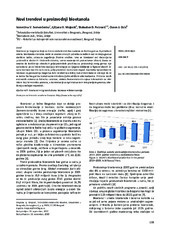Приказ основних података о документу
Novi trendovi u proizvodnji bioetanola
Recent trends in bioethanol production
| dc.creator | Semenčenko, Valentina | |
| dc.creator | Mojović, Ljiljana | |
| dc.creator | Petrović, Slobodan | |
| dc.creator | Ocić, Ozren | |
| dc.date.accessioned | 2022-04-28T11:58:53Z | |
| dc.date.available | 2022-04-28T11:58:53Z | |
| dc.date.issued | 2011 | |
| dc.identifier.issn | 0367-598X | |
| dc.identifier.uri | http://rik.mrizp.rs/handle/123456789/872 | |
| dc.description.abstract | Bioetanol je biogorivo koje se širom sveta koristi kao zamena za fosilna goriva. Upotrebom smeša bioetanola i benzina može se znatno smanjiti potreba za naftom kao i emisija gasova staklene bašte, odnosno zagađenje životne sredine. Iako se bioetanol već decenijama proizvodi iz skrobnih i šećernih sirovina, useva namenjenih prvenstveno ishrani, danas se smatra da korišćenje obradivih poljoprivrednih površina za proizvodnju ovog goriva nije opravdano pa se intenzivno razvijaju tehnologije za njegovo dobijanje iz lignoceluloznih izvora biomase kao što su šumski, poljoprivredni i komunalni otpad. Upotreba lignocelulozne biomase za proizvodnju biogoriva biće neizbežna u bližoj budućnosti kada se očekuje da će se tečna fosilna goriva morati zameniti obnovljivim održivim alternativama. Primena novih enzimskih sistema za hidrolizu celuloze, sinteza fermentativnih sojeva tolerantnih na inhibitore koji fermentišu pentozu, u kombinaciji sa optimizovanom integracijom procesa, obećavaju značajan napredak. | sr |
| dc.description.abstract | The rapid depletion of the world petroleum supply and the increasing problem of greenhouse gas effects have strengthened the worldwide interest in alternative, nonpetroleum sources of energy. Bioethanol accounts for the majority of biofuel use worldwide, either as a fuel or a gasoline enhancer. Utilization of bioethanol can significantly reduce petroleum use and exhaust greenhouse gas emission. The production of this fuel has been increasing over the years, and has reached the level of 73.9 billion liters during the year 2009. Even though for decades ethanol production mainly depended on energy crops containing starch and sugar (corn, sugar cane etc.), new technologies for converting lignocellulosic biomass into ethanol are under development today. The use of lignocellulosic biomass, such as agricultural residues, forest and municipial waste, for the production of biofuels will be unavoidable if liquid fossil fuels are to be replaced by renewable and sustainable alternatives. For biological conversion of lignocellulosic biomass, pretreatment plays a central role affecting all unit operations in the process and is also an important cost deterrent to the comercial viability of the process. The key obstacles are: pretreatment selection and optimization; decreasing the cost of the enzymatic hydrolysis; maximizing the conversion of sugars (including pentoses) to ethanol; process scale-up and integration to minimize energy and water demand; characterization and evaluation of the lignin co-product; and lastly, the use of the representative and reliable data for cost estimation, and the determination of environmental and socio-economic impacts. Currently, not all pretreatments are capable of producing biomass that can be converted to sugars in high enough yield and concentration, while being economically viable. For the three main types of feedstocks, the developement of effective continuous fermentation technologies with near to 100% yields and elevated volumetric productivities is one of the main research subjects in the ethanol industry. The application of new, engineered enzyme systems for cellulose hydrolysis, the construction of inhibitor tolerant pentose fermenting strains, combined with optimized process integration promise significant improvements. | sr |
| dc.language.iso | sr | sr |
| dc.language.iso | en | sr |
| dc.publisher | Beograd : Savez hemijskih inženjera Srbije - SHI | sr |
| dc.publisher | Belgrade : Association of the Chemical Engineers of Serbia | sr |
| dc.rights | openAccess | sr |
| dc.rights.uri | https://creativecommons.org/licenses/by-nc-nd/4.0/ | |
| dc.source | Hemijska industrija | sr |
| dc.subject | bioetanol | sr |
| dc.subject | lignocelulozna biomasa | sr |
| dc.subject | biokonverzija | sr |
| dc.subject | bioethanol | sr |
| dc.subject | lignocellulosic biomass | sr |
| dc.subject | bioconversion | sr |
| dc.title | Novi trendovi u proizvodnji bioetanola | sr |
| dc.title | Recent trends in bioethanol production | sr |
| dc.type | article | sr |
| dc.rights.license | BY-NC-ND | sr |
| dc.citation.volume | 65 | |
| dc.citation.issue | 2 | |
| dc.citation.spage | 103 | |
| dc.citation.epage | 114 | |
| dc.identifier.doi | 10.2298/HEMIND100913068S | |
| dc.identifier.fulltext | http://rik.mrizp.rs/bitstream/id/4416/bitstream_4416.pdf | |
| dc.type.version | publishedVersion | sr |


